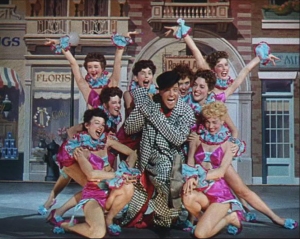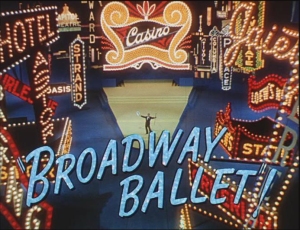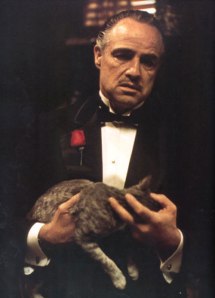Contrary to the title, Singin’ In the Rain is hardly a film that should be watched during a storm, curled up with a blanket and cup of hot chocolate. As comfy as that sounds, this movie musical will have you up tapping your toes to the festive beats. Set in 1927, Singin’ In the Rain follows Don Lockwood (Gene Kelly), one side of Hollywood’s power couple of the silent films. His seemingly better half and co-star, Lina Lamont (Jean Hagen), and best friend Cosmo Brown (Donald O’Connor) join Don through the transition from silent films to talkies; a time the film parodies with mass chaos and jumbled mix-ups. Enter Don’s real-life love, aspiring Broadway actress, Kathy Seldon (Debbie Reynolds) and trouble begins to brew with nasally voiced, conniving Lamont.
Singin’ In the Rain was one film from the long stream of movie musicals from MGM Productions; specifically the Freed Unit. The Freed Unit was a powerhouse in the making of musicals for film, led by Arthur Freed, who not only produced the shows but also wrote compositions as well. This legendary unit consisted of classics such as Vincente Minnelli, Gene Kelly, Fred Astaire and Judy Garland. A few examples from the multiple musicals produced include The Wizard of Oz, Easter Parade and An American in Paris.
While the obvious explanation for what makes a musical different than any other type of movie is the song and dance element, I encourage viewers to not to just see Singin’ In the Rain as any typical musical. The production of each song and synchronized choreography is full of life. Magnificent colors represent the film so vividly it is not only entertaining to dance along to, it is a marvel to see. From the stark contrast of yellow slickers against the shimmering rainy streets to the glittering costumes of the era, even viewers not keen on musicals will be immediately drawn in.
However, Singin’ In the Rain is not only spectacle. The precision of each dance step is a wonder. The way Don and Cosmo’s feet match up perfectly together like there is only one dancer on camera is every dancer’s dream. This type of precision helps tremendously with pulling off the slapstick humor throughout the film. Cosmo, the jest of the film, shows just how much precise dancing helps create the humorous situations in the clip below:
Even if you are not a musical fan, I strongly encourage you to give this movie a chance. Filled with situational irony, romance and laughter, this parody of the transitional years from silent films to talking pictures is sure to give you a glorious feeling. We all know with the identical breakout choreography, musicals are not always the most realistic. But take a break from reality to enjoy a film with the intention of making you smile in the golden age of cinema.
As modern day movie viewers do you believe the movie musical has changed? If so, is it a good thing, or has current movie musicals strayed from their true purpose of entertainment? If you liked Singin’ In the Rain or are interested in more information on the Freed Unit and the other movie musicals created check out Musicals Great Musicals: The Arthur Freed Unit at MGM; a documentary on the making of Freed’s musicals.








